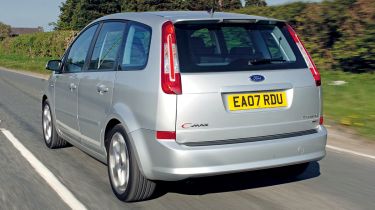Ford C-MAX 2.0 TDCi Titanium
It’s lost the Focus name tag, but thankfully not the great road manners
The latest compact MPVs prove that people carriers don’t have to be dull. The Picasso here is the perfect example, and goes some way to explaining Ford’s decision to overhaul the dull-looking C-MAX. On sale since 2003, it was certainly due a facelift.
The previous ‘Focus’ part of its name has been axed – and with it, the hatchback-inspired shape. Instead, the styling is now more in line with the larger S-MAX; a deliberate ploy by Ford, as it
aims to align the two models more closely.
Working from the back, there are very few immediate differences: only fresh LED light clusters and a new badge. But it’s at the front where the biggest changes have taken place. Angular headlights, a large trapezoidal lower grille and a redesigned front bumper with stylish vertical foglights help the model stand out from its predecessor. Although the updates are hardly wide-ranging, the results are a success; the C-MAX has a more athletic and distinctive appearance.
The changes to the interior provide a more sophisticated feel. Our car had the optional sat-nav system that also incorporates air-con controls. But standard models get new switchgear, with contemporary dials replacing buttons. Better-quality materials and stylish orange ambient lighting also help raise the C-MAX’s game.
The seating position is excellent. It’s more cockpit-like than either rival’s, thanks to the high-mounted gearlever and centre console so, although it doesn’t feel as spacious, it is more driver-oriented. Visibility is an issue, though – obstructive A-pillars make leaving junctions tricky.
Rear passenger accommodation is also good. The optional £400 panoramic sunroof makes the compartment seem light and includes sliding blinds if it’s too sunny. Although there isn’t as much legroom as in the Altea XL, it is equally spacious. The seating layout is versatile, too – the middle chair can be flipped out of the way,
so the two outer seats can be moved diagonally backwards and inwards, creating more legroom if you need to accommodate only four people.
In terms of load carrying capability, the C-MAX trails behind its rivals, with a 60-litre deficit to the Altea XL. But thanks to the removable seats, the Ford’s overall capacity is a considerable 1,633 litres – that’s only 100 litres fewer than the taller and wider Citroen.
What’s most impressive about the C-MAX is its road manners. The suspension set-up is as firm as the Altea’s, ensuring it handles well, although more forgiving damper settings mean that the ride is much smoother. It’s no match for the Citroen, but does a better job of ironing out road imperfections than the SEAT.
The Ford also has the best engine. While the 2.0-litre TDCi unit sounds a little harsh on start-up, once on the move, it is hushed and refined, particularly compared with the SEAT’s engine.
It matches the Spanish machine’s 320Nm of torque and, with only 4bhp less power, it’s no surprise the C-MAX was only fractionally slower at the test track. On the road, it feels equally quick, though, especially at motorway speeds, where it is more willing than either rival.
This comes at a price, however. The Ford is expensive in this company and, despite being the range-topping Titanium model, our test car still has a fairly lengthy options list, including stability control and parking sensors – items we’d expect to see as standard for this money.
Details
Price: £18,745
Model tested: Ford C-MAX 2.0 TDCi Titanium
Chart position: 2
WHY: Now known as the C-MAX, rather than Focus C-MAX, Ford’s contender is tackling the class’s best head on.
Economy
Although our test route involved lots of motorway cruising, the Ford returned only 35.8mpg – the worst here. But it came to us with only 1,000 miles on the clock, so we would expect to see economy improve over time.
Residuals
Our figure for the Ford is taken from the pre-facelift model, and although it’s likely to increase slightly for the latest version, it’s still poor. After three years, the C-MAX is worth £6,505 – only 34.7 per cent of its new price.
Servicing
Both the Ford and Citroen need servicing every 12,500 miles. However, the blue oval model works out as the cheaper of the two to maintain – the first three visits to the main dealer will set C-MAX owners back £625.
Tax
While it emits more CO2 than the Picasso, the C-MAX qualifies for the same 20 per cent tax bracket. But the higher list price doesn’t work in the Ford’s favour here, as it makes the car the more costly company choice of the two.



